What is continuous testing? Here's what you need to know
Did you know that fixing a software bug after a product has been launched can cost up to 100 times more than resolving it during the initial stages of development? The significance of Continuous Testing in present-day software development cannot be overstated. This approach involves incorporating testing at every stage of the development process, which helps to minimize errors and costs that arise during the later stages. Our article provides a simple and direct insight into continuous testing, which is pivotal for anyone in the technology industry.
This article will cover:
- What is continuous testing
- Essential elements of continuous testing
- Benefits and challenges
Want to drive your global growth in local markets?
We can help you drive global growth, better accessibility and better product quality at every level.
What is continuous testing – The definition
Continuous testing in DevOps or Agile is an approach to software testing in which applications are tested at every stage of the software development life cycle (SDLC). Its goal is to enhance software quality and development efficiency in the continuous delivery process.
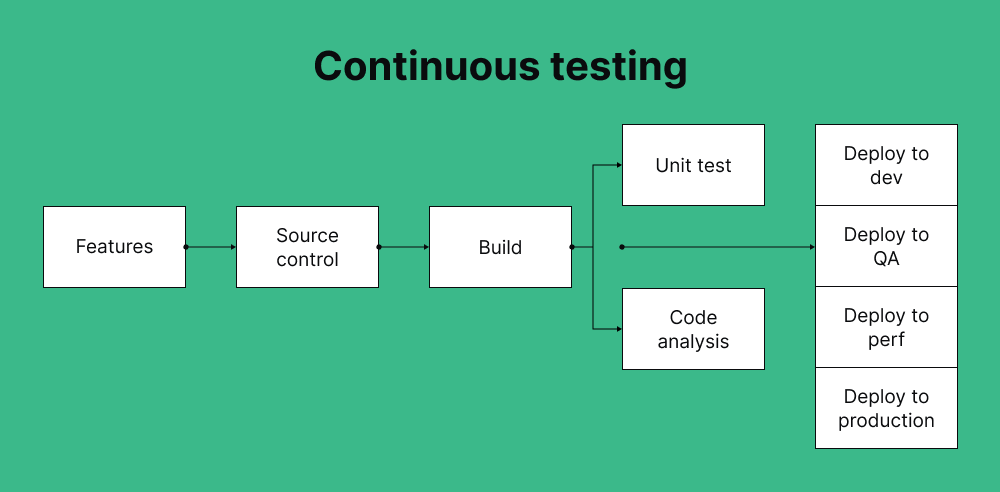
Why does the “continuous testing” idea exist?
Continuous testing is a best practice typically associated with DevOps or Agile methodology. The idea is that smaller and more regular software development life cycles (SDLCs) are beneficial because they provide feedback throughout the entire software delivery process. Continuous testing is an essential aspect of this process since it helps ensure quality. By catching bugs early on, companies can save both time and money, as fixing issues in production can be quite expensive.
However, implementing continuous test delivery can be challenging since it requires rapid feedback loops and a high degree of test automation. This can be difficult to achieve with a fixed supply of in-house testers. We'll go over it in more detail below.
Essential elements of continuous testing
Now, let's explore the essential elements of continuous testing to assess its suitability for your organization.
Test automation
Manual testing, while thorough, is time-consuming and requires extensive labor. Automation, on the other hand, frees up engineers' time, allowing them to focus on resolving bugs discovered during testing.
But it's important to recognize that not all aspects should be automated. Exploratory testing remains vital in creatively identifying new testing scenarios, which can later be automated.
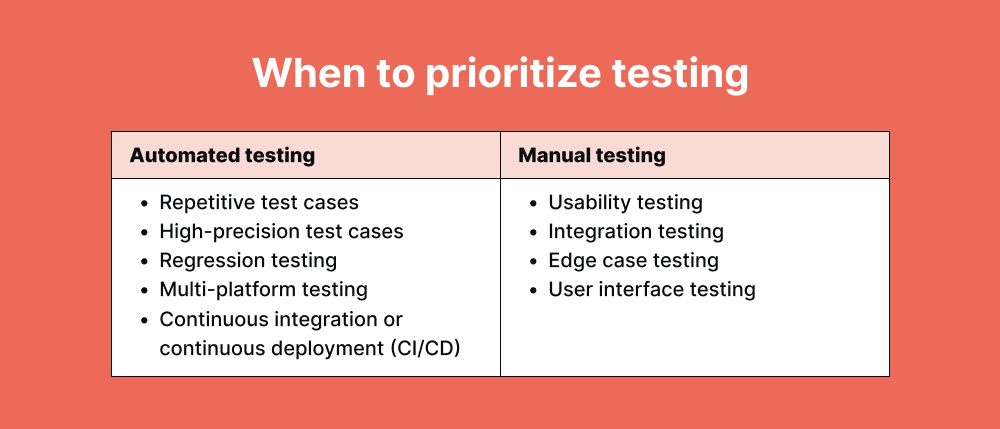
The essence of continuous testing lies in its reliance on test automation. A significant advantage of test automation is the rapid feedback provided to the team, enabling early and frequent adjustments well ahead of market releases. The ultimate aim of continuous testing is seamless execution without human intervention, aligning with the principles of Continuous Integration (CI) and Continuous Delivery (CD).
Continuous Integration
Continuous Integration (CI) is a key process in software development where developers frequently merge their code into a shared repository, sometimes multiple times a day. This approach enables the automatic building of software, offering rapid feedback on its quality. Additionally, automation and testability are fundamental to CI.
Continuous Integration (CI) is a process different from continuous testing. Its primary purpose is to consistently and repeatedly put together a configuration. This enables developers to automatically build upon each code commit, run test suites for each build, and maintain a consistent testing environment. CI provides immediate feedback, which helps to enhance accountability.
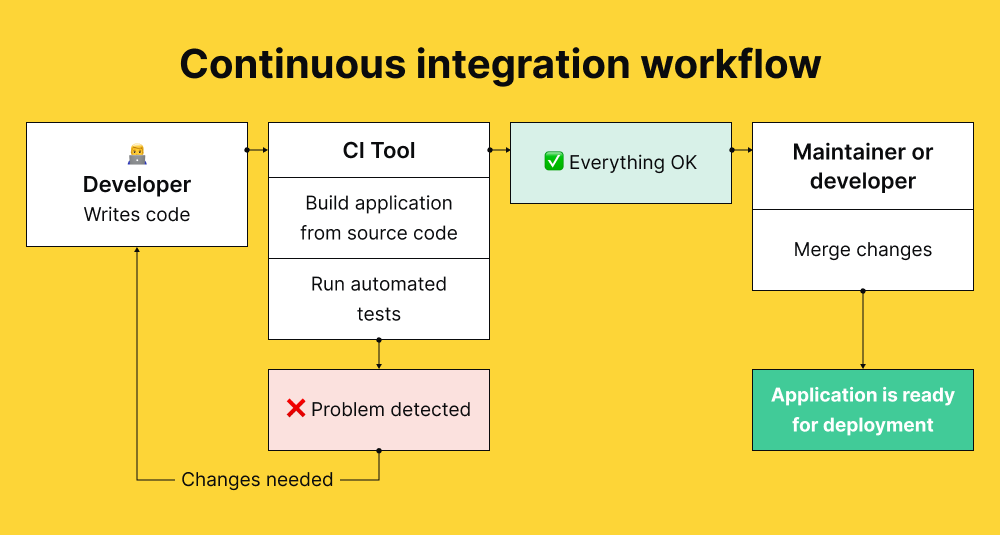
Should a build fail, the CI system halts its progression to subsequent stages. Teams are then notified, enabling them to rectify the issue swiftly, often within minutes. This process makes software development more predictable and reliable. It accelerates the development of new features and the prompt fixing of bugs before they affect users.
Continuous Delivery (CD)
Continuous Delivery (CD) is a method where code modifications are automatically set up for release to the production environment. As a crucial part of contemporary app development, CD extends the principles of Continuous Integration (CI) by deploying code changes to testing environments following the build phase.
Proper implementation of CD ensures that developers consistently have a product ready for deployment that has undergone extensive continuous testing. CD empowers developers to expand their automated testing beyond just unit tests in a test-driven development framework. This comprehensive testing approach allows for thorough verification of app updates across various aspects before they are released to customers.
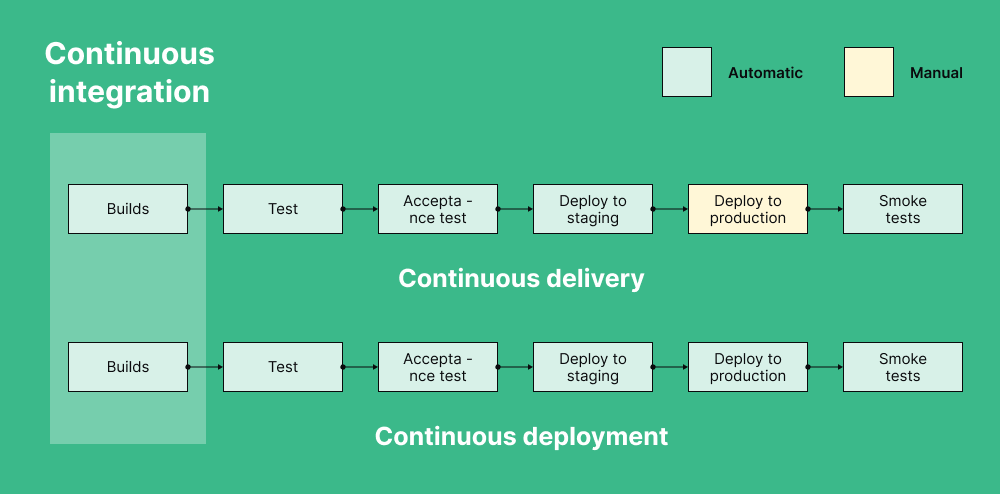
The testing scope in CD typically includes:
- UI (User Interface) testing,
- Load testing to assess performance under stress,
- Integration testing for combined components,
- API (Application Programming Interface) reliability testing, and
- Regression tests to check for new bugs in existing features.
Continuous Delivery (CD) vs. Continuous Deployment
Continuous Delivery (CD) should not be mistaken for continuous deployment. The key distinction is that continuous delivery ensures any code version is ready for production deployment. Still, both practices emphasize small, frequent changes. Continuous Delivery is integral to continuous testing, as it involves thorough code testing before deployment. Deploying untested code is not only a waste of resources but also demands immediate action. Hence, continuous testing of code is imperative.
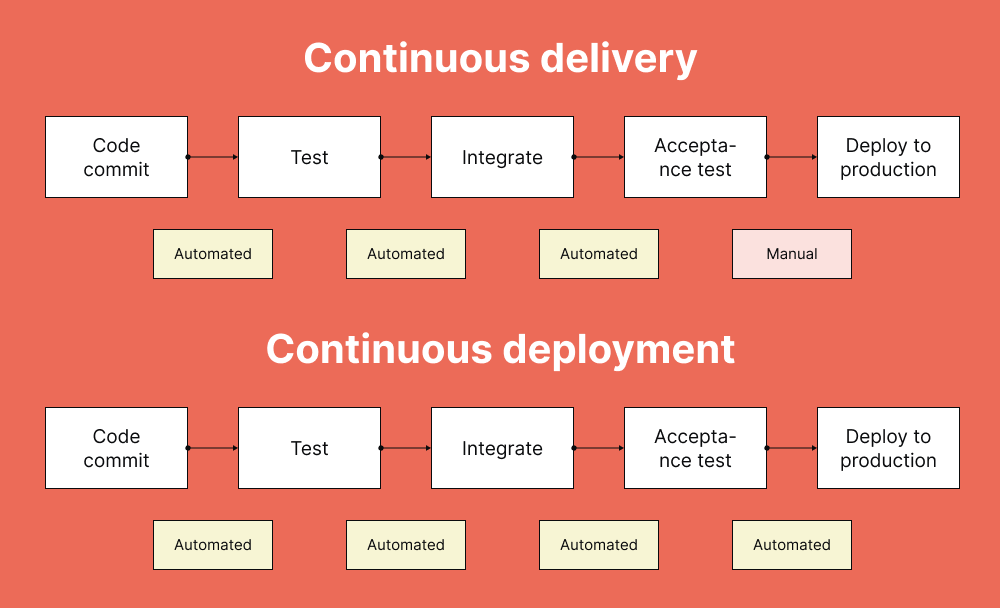
Benefits of continuous testing
Continuous testing offers several key benefits, making it essential in modern software development methodologies like DevOps and Agile. These advantages include:
- Increased speed: Continuous testing aligns with the fast-paced nature of DevOps and Agile, facilitating quicker software delivery. This acceleration can enhance business processes, including faster go-to-market (GTM) strategies.
- Enhanced code quality: By detecting bugs early in the development cycle, continuous testing significantly improves the overall quality of the code, reducing the likelihood of defects.
- Cost efficiency: With a higher standard of code quality and fewer bugs reaching production, continuous testing aims to offset its initial costs over time.
- Improved security: Continuous testing creates a robust framework that protects applications from unforeseen changes and security threats, both during and after deployment.
- Better team communication: The level of collaboration required for effective continuous testing not only aids in identifying bugs more efficiently but also fosters greater alignment among teams regarding broader objectives, such as user experience and commercial goals.
- Quality Assurance standards: Continuous testing sets high standards for the Quality Assurance team, ensuring that the initial investment in aspects such as test automation delivers the expected benefits.
Challenges in implementing continuous testing
Continuous testing poses unique challenges for software development teams despite its many advantages.
- Integration with DevOps: Teams often lack the necessary tools and training to implement continuous testing within Agile and DevOps frameworks effectively.
- Cultural shift: Adopting continuous testing may require a significant cultural change for development and testing teams, especially if they are accustomed to traditional processes.
- Updating testing strategies: Relying solely on conventional testing methods and poorly defined test data management can hinder the effectiveness of continuous testing.
- Regular code integration: Developers who do not integrate their code frequently (ideally several times a day) risk creating problems such as duplicate coding efforts and incompatible code, leading to defects.
- Test environment management: Ensuring that test environments are compatible with the code repository is crucial for the smooth testing of the latest code.
- Production environment alignment: It's vital to align production environments with test environments to guarantee that all software aspects have been thoroughly tested.
Developing a continuous testing framework
For a successful continuous testing framework, testing must be integrated into every phase of the Software Development Life Cycle (SDLC), including design, development, release, and live stages. Consider the following steps:
1. Integrate testing with SDLC stages
Implement tests alongside continuous integration, aiming for at least daily testing. Continuous optimization by the team and management, possibly using DORA (DevOps Research and Assessment) metrics, can further enhance release speed.
2. Test types
Your testing approach should align with your business goals, typically involving a mix of functional and non-functional tests.
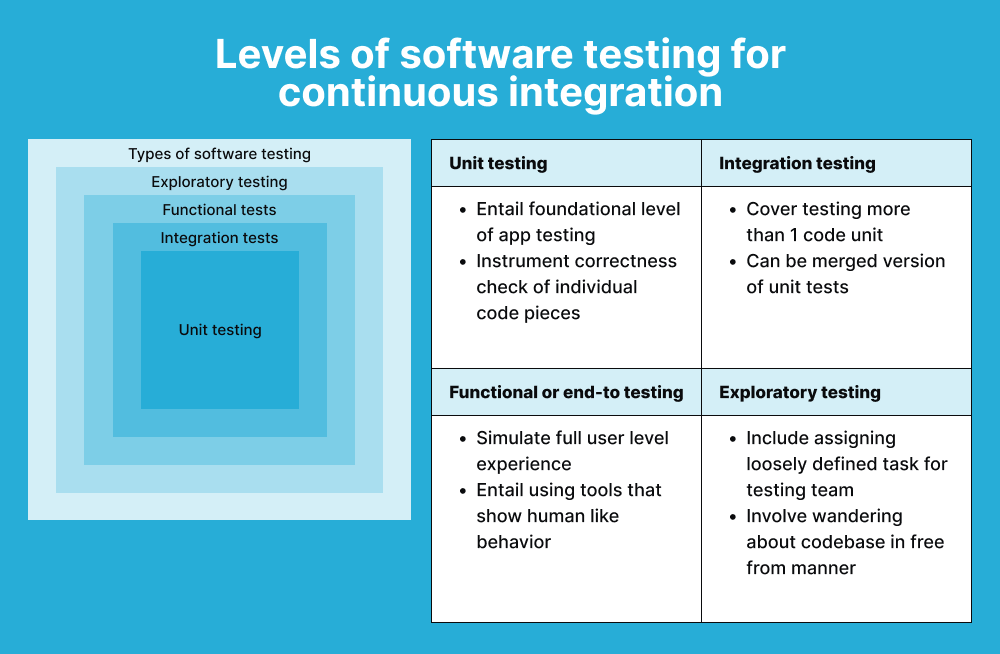
Accelerating continuous testing
To speed up continuous testing and prevent QA teams from becoming bottlenecks due to the increased workload, consider these strategies:
1. Automate tests and manage flaky tests
Automating tests can significantly increase efficiency. However, beware of the challenges, such as overestimating automation capabilities and dealing with flaky tests. Global App Testing and TestRail research shows that businesses often underestimate these issues.
2. Collaborate with a crowdtesting partner
Engaging with a crowdtesting service like Global App Testing can enhance release speed and support continuous testing efforts. Such partnerships offer scalable testing resources and rapid feedback, utilizing a vast pool of testers for simultaneous test execution.
We can help you with continuous testing aligned with your business goals
3. Appoint a dedicated test speed owner
Having a dedicated individual responsible for test speed can significantly improve continuous testing. This role involves advocating for agile testing methods, streamlining processes, and prioritizing automation, thus accelerating test cycles and promoting a culture of continuous improvement.
Continuous testing in production
Continuous Testing in Production (CTIP) represents an advanced level of continuous testing, integrating it directly into the production environment. This approach allows for real-time monitoring and validation of software applications with actual users. While CTIP is valuable, it should complement, not replace, continuous testing in earlier stages. Innovative applications of CTIP include using live product testing to identify optimal commercial opportunities, especially regarding globalization.
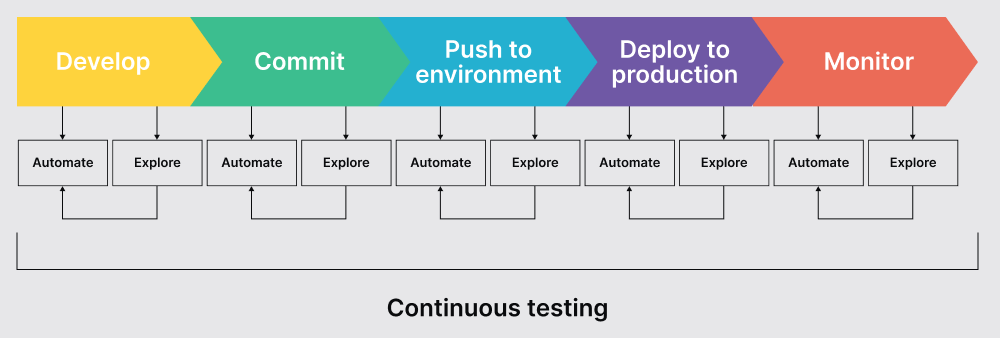
Automated test tools in continuous testing
An automated test tool, also known as an automated testing tool, is software designed to automate the execution of test cases and verify the functionality of an application or system. These tools interact with the application under test, simulate user actions, and compare the actual outcomes with expected results.
Automated test tools help streamline the testing process, increase test efficiency, and enable quicker feedback, reducing the time and effort required for repetitive and labor-intensive manual testing tasks. They are commonly used in software development and quality assurance to ensure the reliability and stability of software products.
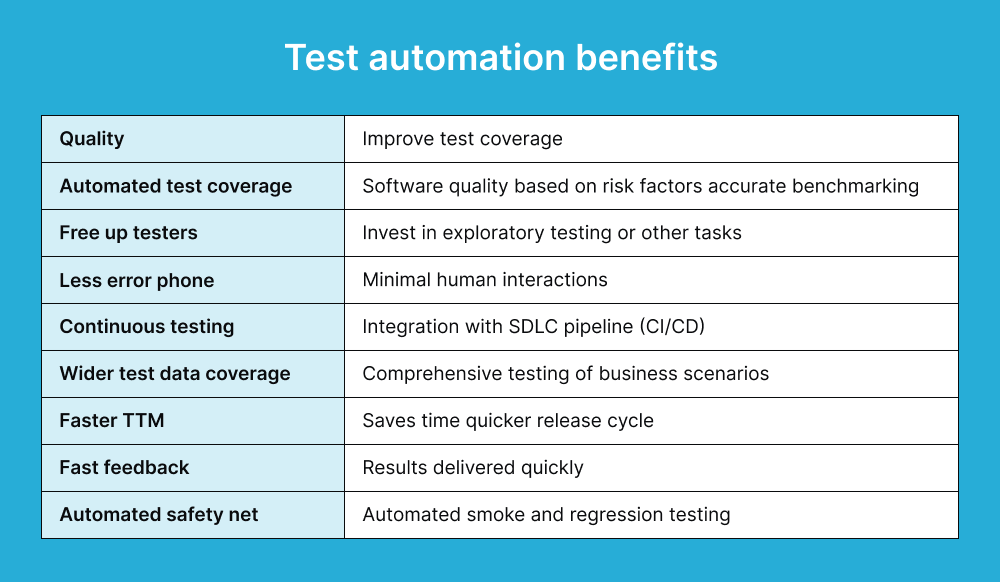
How can Global App Testing help your business?
Global App Testing is a company that utilizes crowdsourced testing, also known as "crowdtesting," to access a wide array of professional software testers for app evaluation. This approach offers several benefits:
- Functional testing: A mix of exploratory tests and test cases to streamline the QA process, improve quality, and deliver features more rapidly. This includes testing at every stage of the Software Development Life Cycle (SDLC), ensuring that products meet specifications, and identifying any bugs or usability issues.
- Platform integration: With popular tools like Jira, TestRail, GitHub, and Zephyr, it is easy to incorporate into existing workflows. It also features an API for seamless integration with continuous integration systems.
- Global testing coverage: Global App Testing offers testing services in over 190 countries, allowing for comprehensive localization and internationalization testing. This guarantees that software runs smoothly across various regions, devices, and operating systems.
- Usability and UX Testing: To better understand how real users in different countries interact with your application, ensuring global experience and accessibility standards are met.
- Add-on services: Apart from standard testing services, Global App Testing provides additional services like test case suite building, competitor benchmarking, and consultancy tailored to specific needs.
- Scalable testing capacity: The large pool of testers means that the number of tests you can launch is only limited by your requirements; the supply of testers can meet your demand.
For those interested in exploring crowdtesting, Global App Testing offers consultations with QA experts. You can start by filling out the form below to discuss your specific testing needs.
FAQ
How is Continuous Testing different from traditional testing?
Unlike traditional testing, which often occurs at the end of the development cycle, Continuous Testing is integrated throughout the software development lifecycle. This integration enables earlier detection and resolution of errors, improving the software's overall quality.
What are the key components of Continuous Testing?
Key components include:
Test automation.
A robust testing environment.
Immediate feedback mechanisms.
Integration with the software delivery pipeline.
Can Continuous Testing be fully automated?
While automation is a significant part of Continuous Testing, it's not exclusively automated. Some aspects, like exploratory testing, may still require manual effort.
Does Continuous Testing require a cultural change in the organization?
Yes, implementing Continuous Testing often requires a shift in culture towards more collaboration between development, testing, and operations teams.
What is the difference between test automation and continuous integration?
Test automation involves using software to conduct tests and generate results based on application requirements or user stories, ensuring specific functions perform correctly. Continuous integration is a more comprehensive approach that involves regularly merging code changes into a central repository, followed by automated builds and tests. Its goal is to confirm that new changes harmonize with existing code without causing errors, thus maintaining code quality and facilitating swift, reliable software delivery.

